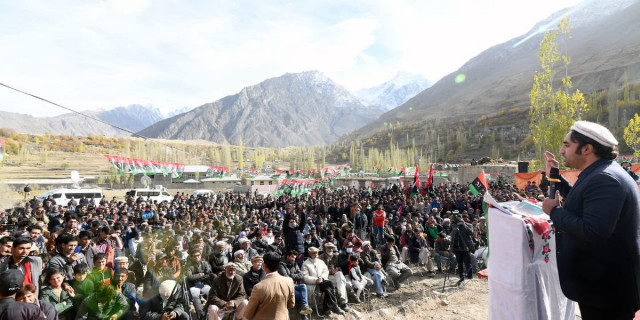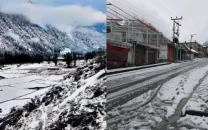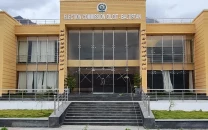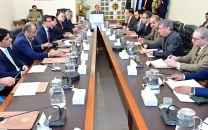Winds of change or more empty promises?
Once again, their biggest fear is that the mainstream political parties will abandon G-B once the vote is over

All eyes are on Gilgit-Baltistan (G-B) today, as voters cast their ballot in one of the most hotly contested polls in the history of the mountainous territory that stretches across northern Pakistan.
Situated at the confluence of world’s greatest mountain peaks – the Karakoram, the Himalaya, the Hindukush, and the Pamir, G-B is now the battleground for all political parties. The contest has brought all mainstream leaders to the region that was once known for being a centre of rivalries between several empires, including the Russian and the British.
Some of these political leaders have camped in the region for weeks. Pakistan People’s Party (PPP) Chairman Bilawal Bhutto Zardari was the first to arrive. The young PPP leader has steered his party’s campaign since then. Following in the footsteps of the PPP supremo, the Pakistan Muslim League Nawaz vice president Maryam Nawaz has also been on the campaign trail, mostly using the spotlight to take potshots at the ruling Pakistan Tehreek-e-Insaf (PTI).
With the two leading opposition parties actively trying to convince voters in the region, the ruling party couldn’t have stayed out of the ring. The high-stakes election also brought Prime Minister Imran Khan to rally voters in the most scenic part of the country. Last month, in what appeared to be a surprise decision, the PTI government decided to elevate G-B to the status of Pakistan’s fifth province.
The move comes a decade after the region was given the semi-provincial status by the PPP. Under the previous system, G-B was ruled by the central government. The region had a legislative council with 24 directly elected members, headed by an elected deputy chief executive, who had limited administrative and financial powers.
Administrative, political and economic reforms have been on the cards for a very long time. It has been a longstanding demand of the people of the region. Last month’s announcement by Prime Minister Imran Khan, making G-B a provisional province, grants the region more autonomy and power for its legislative assembly. Many believe the much-anticipated move by the prime minister is aimed at winning over voters in the region.
With G-B’s significance growing by the day on the regional stage, it has now emerged as a prized trophy that all domestic political parties are eyeing on. The ruling political party has dispatched a number of key cabinet ministers to the area. Similarly, other parties including the main opposition PML-N and PPP are also running an active political campaign to win the hearts and minds of voters in G-B.
The theme for this year’s election is not very unique. Voters are being promised that the region will have more constitutional rights. But such slogans have echoes in the beautiful mountainous region many times.
Historically, the political party that forms the centre government also controls G-B. After the voting is over, the elected representatives are cajoled into joining the ruling party. This year, the PTI has already managed to convince ten representatives, who previously ran on PML-N’s ticket, to join its ranks.
The campaign this year is once again about enticing voters. Along with the tall promises that are rarely fulfilled, the top political leadership of the country is also using the opportunity to trade barbs over who is at fault for the overall economic situation in Pakistan and more. For the people of G-B, these political campaigns have delivered very little. Once the election is over, the leadership rarely revisits the promises made during the campaign.
Voters mostly feel betrayed in the region. Once again, their biggest fear is that the mainstream political parties will abandon the people of G-B once the vote is over. The population of G-B is hoping that the leadership will fulfill the promises made during the campaign.
Geostrategic jewel
Acknowledged as ‘Asia’s fulcrum’ by British historian John Keay, G-B rose to prominence after it became an important part of the China-Pakistan Economic Corridor (CPEC), an infrastructure project running through Pakistan, which is viewed as the crown jewel of President Xi Jinping’s belt and road initiative.
Situated on the gateway between China and Pakistan, the CPEC project has attracted the attention of all regional players. According to analysts, the CPEC project has enhanced G-B’s geopolitical profile once again bringing it back on the map as an important region.
The resurgence of G-B, many strategists believe, is a replay of the 19th century geopolitical and strategic wrangling known as the Great Game between Russia and British India in this region. Under the CPEC project, G-B has acquired a new and enhanced geopolitical importance, which is likely to keep the area in the spotlight for decades.
Famous natural disaster
About ten years ago, the region made headlines due to a natural disaster that killed several people and displaced thousands. A huge landslide hit the village of Attabad in the Hunza Valley.
Not only did the landslide block the Hunza River for weeks, but also disconnected the Karakoram Highway (KKH) between Pakistan and China. Much of the area remained cut off for months. The flow of Hunza River was also obstructed for about five months because of the landslide.
The incident gave birth to a new lake altogether, which flows along the narrow valley. Ten years later, the Attabad Lake is the primary reason for people’s livelihood in the region. It has attracted thousands of visitors to the area, making it a famous spot for tourists from within and outside Pakistan.


















COMMENTS
Comments are moderated and generally will be posted if they are on-topic and not abusive.
For more information, please see our Comments FAQ